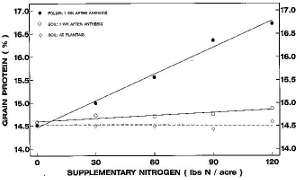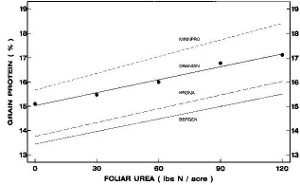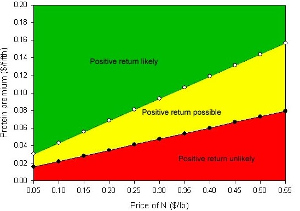By Jochum Wiersma and Albert Sims
The interest to improve grain protein in hard red spring wheat (HRSW) with an in-season application of nitrogen (N) fertilizer usually peaks following years with large grain protein discounts/premiums. With the price outlook of N fertilizer and the desire to reduce overall fertilizer input costs, the practice of in-season applications of nitrogen warrants some review.
The objective of split applications of N is to supply N when the crops needs it and improve the overall N use efficiency and consequently allow maximum grain yield and/or grain protein to be attained with fewer N fertilizer inputs. There is an intuitive appeal to split applications on N in HRSW as the crop will take the majority of its N up between jointing and flag leaf emergence.
The practice of splitting the total N fertilizer gift in three or even four separate applications is commonplace in winter cereal production in the maritime regions of Europe, including the countries of Denmark, the Netherlands, the United Kingdom, and France. The objective of the split applications is to improve both grain yield and grain protein content.
The current N recommendation for HRSW is based on the forecasted need for N, a previous crop nitrogen credit, and the amount of nitrate nitrogen already present estimated by a nitrate soil test. In other words:
N = (2.5 x YG) - NPC - STN (0-24)
With N= the amount of N fertilizer needed, YG = the yield goal, NPC= the previous crop credit, and STN (0-24) = the amount of nitrate nitrogen found in the top 24 inches of soil by the soil nitrate test. This equation was derived from a large number of nitrogen response experiments that were conducted in the tri-state area. An example of such an experiment is Figure 1.
Figure 1. An example of a nitrogen rate experiment in HRSW in which grain yield is measured at 5 incremental increases in the amount of pre-plant nitrogen fertilizer. This particular experiment was conducted in Crookston, MN in 2005.
In Figure 1, we find a classical quadratic response curve in which the response in grain yield declines as additional amounts of N fertilizer is added. Ultimately, the yield plateaus and additional N does not result in any yield increase. At that point, N is no longer rate-limiting. Unfortunately, because of the market demands for HRSW, we also have to consider grain protein. The response of grain protein percentage to N fertilizer from the same experiment as Figure 1 is illustrated in Figure 2.
Figure 2. An example of a nitrogen rate experiment in HRSW in which grain protein percentage is measured at 5 incremental increases in the amount of pre-plant nitrogen fertilizer. This particular experiment was conducted in Crookston, MN in 2005.
The two graphs show a clear difference. N will become rate-limiting for grain protein much sooner than it will be for grain yield. Given this fact, what opportunities do we have to intervene and improve grain protein with split applications of N?
Already in the early nineties, George Rehm and John Lamb evaluated the practice of split applications of N to improve grain yield and grain protein in HRSW. They concluded that adequate pre-plant N sufficed for maximum grain yield and that additional nitrogen at late tillering only had an effect on grain yield if the amount of available N pre-plant was insufficient for the yield goal ultimately attained. The split application of N improved grain protein when the amount of available N pre-plant was insufficient for the yield goal ultimately attained.
To improve grain protein, the European research had shown that supplemental N applications at flag leaf emergence or later were most beneficial. John Wiersma at the University of Minnesota and Greg Endres and Bill Schatz at North Dakota State University evaluated whether late-season applications of nitrogen could improve grain protein in HRSW. John Wiersma evaluated the response in grain protein of four HRSW varieties to 30, 60, 90, and 120 lbs of supplemental N/A. The experiment had a 150 lbs N/A available at the time of planting. The supplemental N was applied as urea granules at planting, as a urea solution soil-applied one week after anthesis, and as a urea solution applied foliar in four applications every four days beginning one week after anthesis. The research showed that:
- Foliar applied N resulted in the largest increase in grain protein (Figure 3).
- The four varieties responded equal to the supplemental nitrogen (Figure 4).
- The supplemental N had no effect on test weight, kernel weight or grain yield (data not shown).
- About 60 lbs N/A applied foliar was needed to increase grain protein one percentage point (Figure 3).

Figure 3. Increases in grain protein concentration with increasing N rate: Comparison of the method and timing of application, Crookston 1993.

Figure 4. Grain protein responses of four HRSW varieties to foliar urea applied sequentially, beginning one week after anthesis, Crookston 1993
When considering the attained grain yield of approx. 60 bu/A, we can also conclude that the amount of pre-plant N was sufficient to maximize grain yield. The efficiency of the supplemental N can be expressed as the ratio of the amount of grain protein produced and the amount of N applied. In this experiment, this ratio was 0.50.
Greg Endres and Bill Schatz evaluated the use of a solution of equal parts water and a 28-0-0 solution of UAN. Fifteen and 30 lbs N/A were applied immediately after anthesis on six HRSW and two durum varieties. The experiment had 100 lbs N/A available at planting. Greg Endres and Bill Schatz found that:
- All varieties responded equally to the supplemental nitrogen.
- The supplemental N had no effect on grain yield, test weight, or kernel weight.
- The UAN solution caused significant leaf burn, with some cultivars giving more leaf burn than others.
- The 30 lbs N/A increased grain protein one percentage point.
Again, when considering the attained grain yield of approx. 40 bu/A, we can conclude that the amount of pre-plant N was sufficient to attain maximum grain yield. The efficiency of the supplemental N in this experiment as expressed as the ratio of the amount of grain protein per acre and the amount of supplemental N was 0.95.
Thus, foliar applications N solutions are the most efficient method to improve grain protein when applied during the early stages of grain fill. The amount of grain protein that can be expected will likely be 50% to 95% of the amount of supplemental N applied. No effects on grain yield, test weight, or kernel weight can be expected.
However, the practical implementation of this input of supplemental N late in the season is cumbersome since we currently lack a good method to predict the final grain protein content. In other words, we can not predict whether the supplemental N will improve grain protein from 12.5 to 13.5 or from 14.5 to 15.5.
Based on the results on John Wiersma, Greg Endres, and Bill Schatz, we have attempted to make a decision model that relates the height of protein premium and the price of the supplemental N. The assumptions of this decision model are:
- The height of the premium/discount per fifth point of grain protein is constant.
- The expected amount of grain protein to be gained from the supplemental N is constant and thus the increase in grain protein percentage is smaller as grain yield increases.
- A single application of 30 lbs N/A is made with and application cost of $3.00/A
Based on the relative efficiencies of 0.5 to 0.95 attained in the experiments described above, we can calculate when supplemental N to improve grain protein will unlikely, possible, and likely result in a positive net return (Figure 5).

Figure 5. The likelihood of a positive net return for different N prices and protein premiums
In summary, grain protein can be improved with supplemental N when applied in a liquid form. Foliar applications just after anthesis when the crop is in the watery ripe stage are the most effective and should not impact grain yield, test weight, or kernel weight despite the potential to cause substantial leaf burning. To minimize leaf burn apply a maximum of 10 gallons of UAN with an equal amount of water. Apply when conditions favor the solution to stay on the canopy and not evaporates quickly. The best time to apply it is during the evening hours when temperatures approach the dew point and winds have died down.